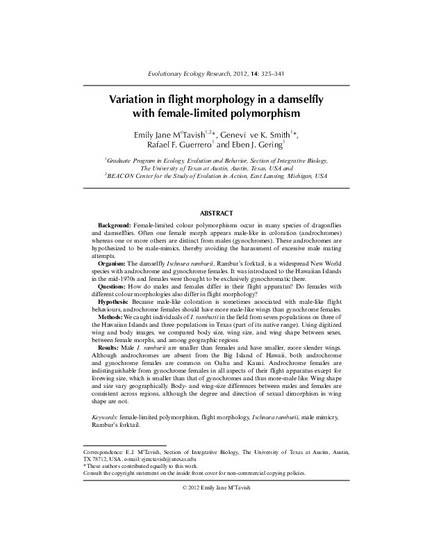
- Female-limited polymorphism,
- Flight morphology,
- Ischnura ramburii,
- Male mimicry,
- Rambur's forktail
- Biology and
- Life Sciences
Background: Female-limited colour polymorphisms occur in many species of dragonflies and damselflies. Often one female morph appears male-like in coloration (androchromes) whereas one or more others are distinct from males (gynochromes). These androchromes are hypothesized to be male-mimics, thereby avoiding the harassment of excessive male mating attempts.
Organism: The damselfly Ischnura ramburii, Rambur’s forktail, is a widespread New World species with androchrome and gynochrome females. It was introduced to the Hawaiian Islands in the mid-1970s and females were thought to be exclusively gynochromatic there.
Questions: How do males and females differ in their flight apparatus? Do females with different colour morphologies also differ in flight morphology? Hypothesis: Because male-like coloration is sometimes associated with male-like flight behaviours, androchrome females should have more male-like wings than gynochrome females.
Methods: We caught individuals of I. ramburii in the field from seven populations on three of the Hawaiian Islands and three populations in Texas (part of its native range). Using digitized wing and body images, we compared body size, wing size, and wing shape between sexes, between female morphs, and among geographic regions.
Results: Male I. ramburii are smaller than females and have smaller, more slender wings. Although androchromes are absent from the Big Island of Hawaii, both androchrome and gynochrome females are common on Oahu and Kauai. Androchrome females are indistinguishable from gynochrome females in all aspects of their flight apparatus except for forewing size, which is smaller than that of gynochromes and thus more-male like. Wing shape and size vary geographically. Body- and wing-size differences between males and females are consistent across regions, although the degree and direction of sexual dimorphism in wing shape are not.
Available at: http://works.bepress.com/eben-gering/7/

© 2012 Emily Jane McTavish. All EER articles are copyrighted by their authors. All authors endorse, permit and license Evolutionary Ecology Ltd. to grant its subscribing institutions/libraries the copying privileges specified below without additional consideration or payment to them or to Evolutionary Ecology, Ltd. These endorsements, in writing, are on file in the office of Evolutionary Ecology, Ltd. Consult authors for permission to use any portion of their work in derivative works, compilations or to distribute their work in any commercial manner.